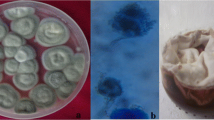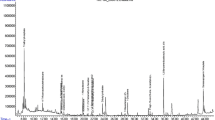Abstract
The Culicinomyces clavisporus is a fungal pathogen of a wide range of mosquito larvae. The C. clavisporus was isolated from the larvae of Culiseta inornata. We have investigated into potential pathogenicity against the adults of Culex quinquefasciatus, Aedes aegypti and Anopheles stephensi. The culture filtrates released from the strain of C. clavisporus 46258 were grown in the EmYPss broth, were filtered and used for the bioassays after a growth of 15 days. The results demonstrated these metabolites with LC50, LC90 and LC99 values of C. quinquefasciatus, 5.62, 8.71 and 12.59, A. aegypti, 3.0, 7.0 and 9.3, and A. stephensi 2.69, 6.0 and 7.24 μl/cm2, respectively after exposure for 24 h. These results compared favorably with the commercial adulticide Gokilaht®-S 5EC (d,d-trans-cyphenothrin) that showed 100% mortality at the same concentration. This study successfully identified that the metabolites of C. clavisporus can be used as mosquitoes adulticide as safer alternative to modern synthetic chemical insecticide against mosquito vector of diseases. Further purification can lead to biotechnological exploitation.



Similar content being viewed by others
References
Blanford S, Chan BHC, Jenkins N, Sim D, Turner RJ, Read AF, Thomas MB (2005) Fungal pathogen reduces potential for malaria transmission. Science 308:638–1641
Campbell EI, Kinghorn JR, Kana’n GJ, Unkles SE, Panter C (2002) Genetic transformation of the mosquito pathogenic fungus Culicinomyces clavisporus. Biocontrol Sci Tech 12:395–399
Cooper RD, Sweeney AW (1986) Laboratory studies on the recycling potential of the mosquito pathogenic fungus Culicinomyces clavisporus. J Inverteb Pathol 48:152–158
Couch JN, Romney SV, Rao B (1974) A new fungus which attacks mosquitoes and related Diptera. Mycologia 66:374–379
Fang J (2010) A world without mosquitoes. Nature 466:432–434
Fang W, Vega-Rodríguez J, Ghosh AK, Jacobs-Lorena M, St Kang A, Leger RJ (2011) Development of transgenic fungi that kill human malaria parasites in mosquitoes. Science 331:1074–1077
Farenhost M, Mouatcho JC, Kikankie CK, Brooke BD, Hunt RH, Thomas MB, Koekemoer LL, Knols BGJ, Coetzee M (2009) Fungal infection counters insecticides resistance in African malaria mosquitoes. Proc Natl Acad Sci 106:17443–17447
Ffrench-Constant RH (2005) Something old, something transgenic, or something fungal for mosquito control? Trends Ecol Evol 20:577–579
Finney DJ (1971) Probit analysis, 3rd edn. Cambridge University Press, Cambridge
Frances SP (1986) Record of the mosquito pathogenic fungus Culicinomyces clavisporus Couch, Romney and Rao infecting larvae of Culiseta inconspicua Lee (Diptera: Culicidae) in Victoria. J Aust Entomol Society 25:60
Goettel MS, Sigler L, Carmichael JW (1984) Studies on the mosquito pathogenic hyphomycete Culicinomyces clavisporus. Mycologia 76:614–625
Howard AFV, N’Guessan R, Koenraadt CJM, Asidi A, Farenhorst M, Akogbeto M, Thomas MB, Knols BGJ, Takken W (2010) The entomopathogenic fungus Beauveria bassiana reduces instantaneous blood feeding in wild multi-insecticide-resistant mosquitoes in Benin, West Africa. Parasit Vectors 3:87
Kanzok SM, Jacobs-Lorena M (2006) Entomopathogenic fungus as biological insecticides to control malaria. Trends Parasitol 22:4951
Knols BGJ, Bukhari T, Farenhorst M (2010) Entomopathogenic fungi as the next generation control agents against malaria mosquitoes. Future Microbiol 5:339–341
Koella JC, Lynch PA, Thomas MB, Read AF (2009) Towards evolution-proof malaria control with insecticides. Evol Appl 2:469–480
Lacey LA, Undeen AH (1986) Microbial control of black flies and mosquitoes. Annu Rev Entomol 31:265–296
Legner EF (1995) Biological control of Diptera of medical and veterinary importance. J Vector Ecol 20:59–120
Mnyone LL, Kirby MJ, Mpingwa MW, Lwetoilera DW, Knols BGJ, Takken W, Koenraadt CJM, Russel TL (2011) Infection of Anopheles gambiae mosquitoes with entomopathogenic fungi: effect of host age and blood feeding stage. Parasitol Res 108:317–322
Mohanty SS, Raghvendra K, Rai U, Dash AP (2008) Efficacy of female Culex quinquefasciatus with entomopathogenic fungus Fusarium pallidoroseum. Parasitol Res 103:171–174
Prakash S, Singh G, Soni S, Sharma S (2010) Pathogenicity of Fusarium oxysporum against the larvae of Culex quinquefasciatus (Say) and Anopheles stephensi (Liston) in laboratory. Parasitol Res 107:651–655
Quesada-Moraga E, Carrasco-Dıaz JA, Santiago-Alvarez C (2006) Insecticidal and antifeedant activities of proteins secreted by entomopathogenic fungi against Spodoptera littoralis (Lep., Noctuidae). J Appl Entomol 130:442–452. doi:10.1111/j.1439-0418.2006.01079.x
Read AF, Lynch PA, Thomas MB (2009) How to make evolution proof insecticides for malaria control. PLoS Biol 7:e1000058
Rozendaal JA (1997) Vector control: methods for use individuals and communities. World Health Organization, Geneva
Russell RC, Debenham MJ, Lee DJ (1978) A natural habitat of the insect pathogenic fungus Culicinomyces in the Sydney area. Proc Linn Soc New S Wales 103:71–73
Scholte EJ, Njiru BN, Smallegang RC, Takken W, Knols BGJ (2003) Infection of malaria (Anopheles gambiae s.s.) and filariasis (Culex quinquefasciatus) vectors with the entomopathogenic fungus Metarhizium anisopliae. Malaria J 2:29
Scholte EJ, Knols BGJ, Samson RA, Takken W (2004) Entomopathogenic fungi for mosquito control: a review. J Insect Sci 4:19
Scholte E-J, Ng’habi K, Kihonda J, Takken W, Paaijmans K, Abdulla S, Killeen GF, Knols BGJ (2005) An entomopathogenic fungus for control of adult African malaria mosquitoes. Science 308:1641–1642
Singh G, Prakash S (2009) Gokilaht®-S 5EC testing on Culex quinquefasciatus Say larvae for an early detection in esterase and monooxygenase resistance system. Parasitol Res 104:1087–1091
Singh G, Prakash S (2010) Efficacy of Lagenidium giganteum (Couch) metabolites for control Anopheles stephensi (Liston) a malaria vector. Malaria J. doi:10.1186/1475-2875-9-S2-P46
Soni S, Prakash S (2010) Effect of Chrysosporium keratinophilum metabolites against Culex quinquefasciatus after chromatographic purifications. Parasitol Res 107:1329–1336
Sweeney AW (1985) The potential of the fungus Culicinomyces clavisporus as a biological control agent for medically important Diptera. In: Laird M, Miles J (eds) Integrated mosquito control methodologies. Vol 2. Academic Press, London
Thomas MB, Read AF (2007) Can fungal biopesticides control malaria? Nat Rev Microbiol 5:377–383
Unkles SE, Marriott C, Kinghorn JR, Panter C, Blackwell A (2004) Efficacy of the entomopathogenic fungus, Culicinomyces clavisporus against larvae of the biting midge, Culicoides nubeculosus (Diptera: Ceratopogonidae). Biocontrol Scie Tech 14:397–401
Verma P, Prakash S (2010) Efficacy of Chrysosporium tropicum metabolite against mixed population of adult mosquito (Culex quinquefasciatus, Anopheles stephensi, and Aedes aegypti) after purification with flash chromatography. Parasitol Res 107:163–166
World Health Organization (2006) Vector borne diseases in India. Report of a brainstorming session 9 November 2006
World Health Organization (2010a) Guidelines for the treatment of malaria 2nd edition. WHO ISBN 978 92 4 154792 5
World Health Organization (2010b) Global programme to eliminate lymphatic filariasis—progress report on mass drug administration in 2009 weekly epidemiological record 85:38; pp 365–372
Acknowledgements
We thank Prof. V.G. Das, Director, Dayalbagh Educational Institute, for his encouragements. We are also thankful to the DST (C-24 Soam Prakash), UGC New Delhi of major research project for the financial support 2011 and to DST-FIST program (2003–2008) for providing laboratory facilities. G. Singh is indebted to UGC, New Delhi, for an award of Post-Doctoral Fellowship (2009–2011).
Author information
Authors and Affiliations
Corresponding author
Rights and permissions
About this article
Cite this article
Singh, G., Prakash, S. Evaluation of culture filtrates of Culicinomyces clavisporus: Mycoadulticide for Culex quinquefasciatus, Aedes aegypti and Anopheles stephensi . Parasitol Res 110, 267–272 (2012). https://doi.org/10.1007/s00436-011-2482-5
Received:
Accepted:
Published:
Issue Date:
DOI: https://doi.org/10.1007/s00436-011-2482-5




